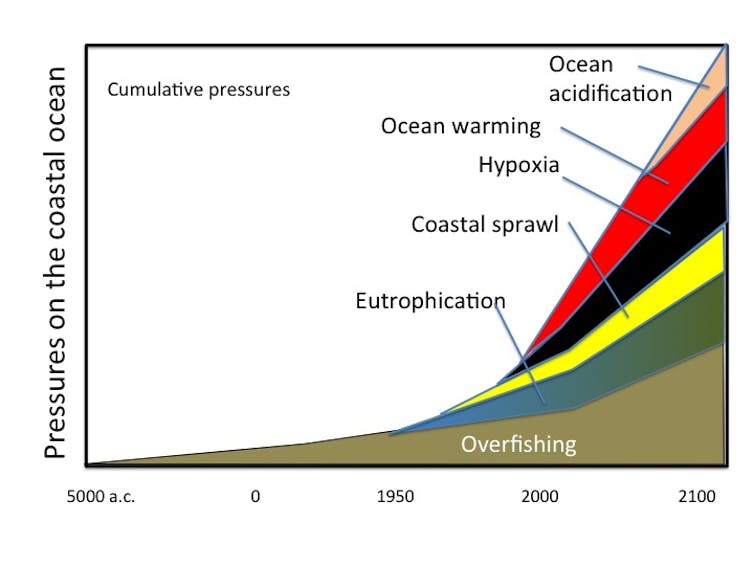Last week, I gave a lecture at the Coastal Institute of the University of Rhode Island entitled “Auditing the Seven Plagues of Coastal Ecosystems”. This lecture was presented as the inaugural annual Scott W. Nixon lecture, celebrating the memory and achievement of Scott W. Nixon, a leading coastal ecologist - and a dear friend- that passed away in 2012. Scott’s research was dedicated to addressing the problems of the coastal ocean, helping define the problems and guide managerial and policy actions to address these problems around the world.
Global population growth and per capita resource use have led to mounting pressure on the biosphere.
These pressures are focused on the coastal zone where human density is highest. The large number of pressures are driving coastal ecosystems to deteriorate globally and creating increasing demands on managers to remove these pressures, mitigate their impacts, and restore coastal ecosystems.
Whereas these problems are real and require urgent attention, they are often conveyed in an unbalanced way, with a tendency to maximize or exaggerate some of these problems. The result is the risk of falling prey to “crying wolf” syndrome.
This is unfortunate because it (a) leads to a dispersal of efforts and resources away from the major problems into addressing issues that are not clearly demonstrated, and (b) deters the public from engaging in addressing the problem as ecologists become identified as bearers of bad news. In my talk I critically assessed the different problems that affect coastal ecosystems at a global scale and evaluated the strength of the applied evidence.
In my assessment I tried to sort out those problems that can be considered major threats needing urgent attention by managers and policymakers from others that remain hypothetical or may not occur at all. Through this process I identified where the narrative dispersed from science and the media to society needs be toned down.
I believe this exercise maybe of interest to the readership of this blog, and thus, will elaborate on these “plagues” in future posts.
But, let me introduce here the plagues.
The Exodus text referring to the plagues already makes reference to coastal plagues: “This is what the Lord says: By this you will know that I am the Lord: With the staff that is in my hand I will strike the water of the Nile, and it will be changed into blood. The fish in the Nile will die, and the river will stink and thus the Egyptians will not be able to drink its water…” (Exodus 7:17–18). This text seems to describe a red tide, a bloom of dinoflagelates (photosynthetic protists) that often leads to a red color in the water, and that contains toxins that can affect humans, livestock and pets. Red tides often lead to mass fish kills that, when decomposing, lead to sulfide development and bad smell. Red tides have been linked to eutrophication, one of the drivers of the modern plagues, referring to the excess production of organic matter resulting from increased nutrient (nitrogen and phosphorus) inputs.
Indeed, the drivers of the problems affecting coastal ecosystems are:
Overfishing
Eutrophication
Habitat alteration
Pollutant inputs
Hypoxia
Warming
Ocean Acidification
All of these pressures are well described and demonstrated, and some of them have affected the coastal ocean for centuries. The earliest evidence of overfishing dates from centuries ago, whereas ocean acidification is possibly the most recent driver, and, for the most part, will only stress marine organisms in some decades into the future.

The consequences of these drivers, the “seven plagues” of the coastal ocean, include:
Increased jellyfish blooms
Increased harmful algal bloom
Fish kills
Proliferation of invasive species
Decline of calcifiers
Decline of vegetated coastal habitats.
Decline of megafauna.
Some of these “plagues” are well documented as global problems, while others act at local or regional scales, and yet others need be reconsidered, as they refer to events for which evidence of increase or deterioration is not yet sufficiently robust.
I argue that some of these “plagues” need be reconsidered, as they may derive from increased research and observation effort providing an increase in reports of some adverse conditions and events. In addition, the severity of some of the “plagues” have been overstated by the media, leading to public concern and the rise of these “plagues” in the research agenda.
There is ample and robust evidence that vegetated coastal habitats and megafauna have declined globally and that the occurrence of invasive species has increased, but is the evidence for the other plagues equally compelling? I will dedicate the next posts to addressing this question. In my next post I will argue that whereas ocean acidification is a real problem, this is largely an open ocean syndrome and evidence of present - and even future - impact on coastal ecosystems need be reconsidered.
